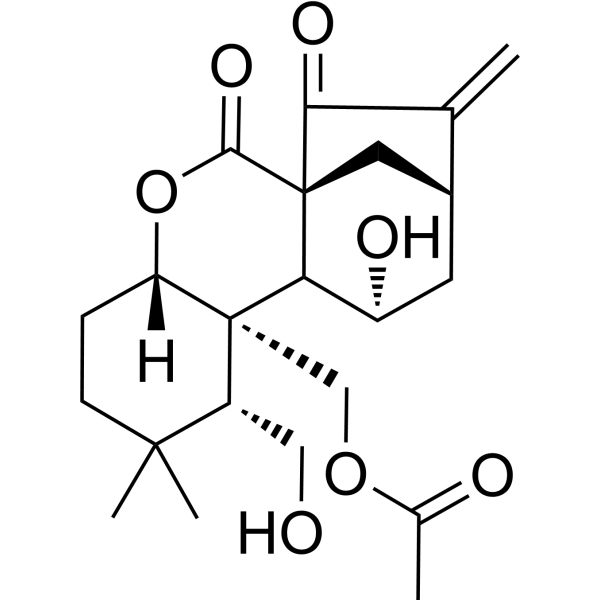Rabdophyllin GCAS# 82460-75-1 |

Quality Control & MSDS
Package In Stock
Number of papers citing our products

| Cas No. | 82460-75-1 | SDF | Download SDF |
| PubChem ID | N/A | Appearance | Powder |
| Formula | C22H30O7 | M.Wt | 406.47 |
| Type of Compound | Diterpenoids | Storage | Desiccate at -20°C |
| Synonyms | Rabdosin C,Isodonoiol | ||
| Solubility | Soluble in Chloroform,Dichloromethane,Ethyl Acetate,DMSO,Acetone,etc. | ||
| General tips | For obtaining a higher solubility , please warm the tube at 37 ℃ and shake it in the ultrasonic bath for a while.Stock solution can be stored below -20℃ for several months. We recommend that you prepare and use the solution on the same day. However, if the test schedule requires, the stock solutions can be prepared in advance, and the stock solution must be sealed and stored below -20℃. In general, the stock solution can be kept for several months. Before use, we recommend that you leave the vial at room temperature for at least an hour before opening it. |
||
| About Packaging | 1. The packaging of the product may be reversed during transportation, cause the high purity compounds to adhere to the neck or cap of the vial.Take the vail out of its packaging and shake gently until the compounds fall to the bottom of the vial. 2. For liquid products, please centrifuge at 500xg to gather the liquid to the bottom of the vial. 3. Try to avoid loss or contamination during the experiment. |
||
| Shipping Condition | Packaging according to customer requirements(5mg, 10mg, 20mg and more). Ship via FedEx, DHL, UPS, EMS or other couriers with RT, or blue ice upon request. | ||

Rabdophyllin G Dilution Calculator

Rabdophyllin G Molarity Calculator
| 1 mg | 5 mg | 10 mg | 20 mg | 25 mg | |
| 1 mM | 2.4602 mL | 12.301 mL | 24.6021 mL | 49.2041 mL | 61.5052 mL |
| 5 mM | 0.492 mL | 2.4602 mL | 4.9204 mL | 9.8408 mL | 12.301 mL |
| 10 mM | 0.246 mL | 1.2301 mL | 2.4602 mL | 4.9204 mL | 6.1505 mL |
| 50 mM | 0.0492 mL | 0.246 mL | 0.492 mL | 0.9841 mL | 1.2301 mL |
| 100 mM | 0.0246 mL | 0.123 mL | 0.246 mL | 0.492 mL | 0.6151 mL |
| * Note: If you are in the process of experiment, it's necessary to make the dilution ratios of the samples. The dilution data above is only for reference. Normally, it's can get a better solubility within lower of Concentrations. | |||||

Calcutta University

University of Minnesota

University of Maryland School of Medicine

University of Illinois at Chicago

The Ohio State University

University of Zurich

Harvard University

Colorado State University

Auburn University

Yale University

Worcester Polytechnic Institute

Washington State University

Stanford University

University of Leipzig

Universidade da Beira Interior

The Institute of Cancer Research

Heidelberg University

University of Amsterdam

University of Auckland

TsingHua University

The University of Michigan

Miami University

DRURY University

Jilin University

Fudan University

Wuhan University

Sun Yat-sen University

Universite de Paris

Deemed University

Auckland University

The University of Tokyo

Korea University
- Wallichoside
Catalog No.:BCX1715
CAS No.:60657-36-5
- 2,3-Dihydro-3-hydroxy-2-oxo-1H-indole-3-acetic acid
Catalog No.:BCX1714
CAS No.:57061-17-3
- Protoapigenin
Catalog No.:BCX1713
CAS No.:879325-07-2
- 2-(trans-1,4-dihydroxy-cyclohexyl)-5,7-dihydroxy-chromone
Catalog No.:BCX1712
CAS No.:1270013-29-0
- Protoapigenin 4'-O-β-D-glucoside
Catalog No.:BCX1711
CAS No.:163559-04-4
- Angulatin E
Catalog No.:BCX1710
CAS No.:403613-20-7
- Angulatin G
Catalog No.:BCX1709
CAS No.:1000784-46-2
- Celangulatin C
Catalog No.:BCX1708
CAS No.:1000784-44-0
- Apigenin 4'-O-β-D-glucopyranoside
Catalog No.:BCX1707
CAS No.:20486-34-4
- Epinodosinol
Catalog No.:BCX1706
CAS No.:27548-88-5
- (1α,2α,6β,8α,9α)-1,2,6,8,12-pentakis(acetyloxy)-9-(benzoyloxy)dihydro-β-agarofuran
Catalog No.:BCX1705
CAS No.:128443-60-7
- Caffeic acid tetramer
Catalog No.:BCX1704
CAS No.:130286-75-8
- Angulatin K
Catalog No.:BCX1717
CAS No.:1631992-80-7
- (2E,4E)-8-Hydroxy-2,7-dimethyl-decadien-(2,4)-disaeure-(1,10)-dioic acid
Catalog No.:BCX1718
CAS No.:2808401-10-5
- Aristol-1(10)-en-9-ol
Catalog No.:BCX1719
CAS No.:114339-94-5
- Maritimetin
Catalog No.:BCX1720
CAS No.:576-02-3
- Polyporoid B
Catalog No.:BCX1721
CAS No.:1042362-45-7
- Polyporoid C
Catalog No.:BCX1722
CAS No.:1042362-47-9
- 2R-3',4',8-Trihydroxyflavanone-7-O-glucoside
Catalog No.:BCX1723
CAS No.:56389-87-8
- 2',3'-Dihydro-2'-hydroxyprotoapigenone
Catalog No.:BCX1724
CAS No.:1365655-88-4
- Angulatin B
Catalog No.:BCX1725
CAS No.:142546-07-4
- Celangulin XIX
Catalog No.:BCX1726
CAS No.:403505-80-6
- Arabidopyl alcohol
Catalog No.:BCX1727
CAS No.:1400234-92-5
- 1α, 2α-diacetoxy-8β-isobutanoyloxy-9α-benzoyloxy-15-β-(β-furancarbonyloxy)-4β, 6β-dihydroxy-β-dihydr...
Catalog No.:BCX1728
CAS No.:2170562-63-5
Screening and Capability Assessment of Tyrosinase Inhibitors in Isodon excisoides by Ultrafiltration Coupled with UHPLC-Q-TOF-MS and Molecular Docking Technology.[Pubmed:36369642]
Chem Biodivers. 2022 Dec;19(12):e202200748.
Tyrosinase inhibitors can alleviate the harm to the liver caused by tyrosinase. How to effectively screen out natural tyrosinase inhibitors becomes a focus. In this study, Isodon excisoides was first extracted with the ultrasound optimized by response surface methodology. Then, a method combined ultrafiltration with ultra-liquid chromatography mass spectrometry (UHPLC/MS) was built to screen and identify tyrosinase inhibitors. The binding energies of active ingredients to tyrosinase were calculated by molecular docking. The reliability of the results was validated by the IC(50) of enzyme inhibition assay. As a result, the binding energies of 7 components including excisanin B, lasiokaurin, Rabdophyllin G, rabdoserrin B, rabdosin D, rabdosinate and weisiensin were lower than that of resveratrol. It was indicated that these components had high tyrosinase inhibitory activity. The IC(50) values of lasiokaurin and excisanin B were 177 and 142 mumol/mL, which were less than that of resveratrol (183 mumol/mL). It showed that this way was simple, rapid, reliable and effective, which provided a new strategy to screen natural bioactive compounds from plants.


